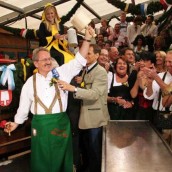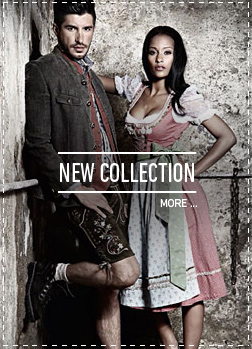Posted by trachten in Bavaria, Oktoberfest | Comments Off on The First Ever Oktoberfest: History of the Oktoberfest
The First Ever Oktoberfest: History of the Oktoberfest

The first ever Oktoberfest was held on 17th October 1810 to celebrate the marriage of Ludwig I, King of Bavaria, to Princess Theresa of Saxony-Hildenburghausen. The couple had actually tied the knot on 12th, so the people of Munich were offered another spectacle on 17th in the form of a horse race; the race was held on the “Wiesn”, a large field then at the edge of the city but now in the heart of Munich, where the Oktoberfest still takes place today.
Wiesn, which means meadow, is Munich slang for both the field – kept free of buildings to this day – and for the Oktoberfest itself. It was named Theresienwiese, or “Theresa’s Meadow”, for the races in 1810, and this is still the name of the underground station which most visitors use to access today’s Oktoberfest.
Everyone had such a great time watching the geegees and eating, drinking, and being merry, that when 1811 came around, it was decided to celebrate the whole thing again. A group of Bavarian farmers put on the festivities to celebrate the country’s (it was still a country at the time) agricultural prowess, and did so again in 1812. In 1813, the Napoleonic Wars put paid to the fourth Oktoberfest, but it kept on going after that.
In 1819, the festival had got so large that the farmers needed help staging it, and that’s where the city of Munich came in. The city fathers decided once and for all to make an annual thing of it, and started to introduce the carnival elements which have remained part of it to this day.
Other classic components of the Oktoberfest followed over the course of the 19th century. In 1850, the Bavaria statue was inaugurated, and despite a few outbreaks of cholera and the odd war or two leading to cancellations, the celebrations went from strength to strength. In 1881, the first chicken rotisserie was opened, starting the tradition of the roast chicken or “Hendl” with beer; soon after, the first proper beer tents replaced the small sales kiosks which had been characteristic until then.
The hundredth anniversary of the Oktoberfest was celebrated in 1910 in the Bräurosl tent, which seated 12,000 – an incredible number for that time. With technological advances, not just the tents, but the rides and rollercoasters got larger and larger, too.
The first half of the 20th century was, however, on the whole somewhat unkind to the Oktoberfest. The First World War, the years of hyperinflation, and then the Second World War meant that the festival was more often cancelled than not.
After the Second World War, it took a few years for the Oktoberfest to come back – and when it did, one important element was missing: horse racing. Apart from the 150th and 200th anniversary years of 1960 and 2010, equine sports have disappeared from the Oktoberfest. In 1950, however, a new tradition was inaugurated: the Mayor of Munich tapped the first keg in Schottenhamel and called out “Ozapft is!”
1980 was a dark year for the Oktoberfest, with a suicide bomber killing thirteen festival-goers at the entrance. Nevertheless, this had not effect on the Oktoberfest’s popularity worldwide, as modern communications and tourism helped visitors numbers grow and grow throughout the 80s and 90s: by the turn of the millennium, the Oktoberfest was welcoming on average six million visitors a year and was by some distance the largest public festival in the world.
The years since 2000 have seen the party atmosphere at the Oktoberfest grow as the crowds get younger and the music gets louder. During the daytime, however, the festival remains a traditional, family friendly event. Another big change is the recent explosion in the popularity of Bavarian costumes such as traditional lederhosen and traditional dirndl outfits, formerly only worn by true Bavarians from the surrounding countryside and now a popular staple with tourists.

